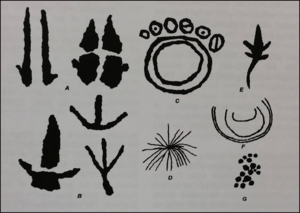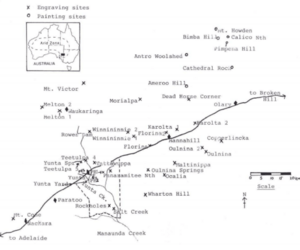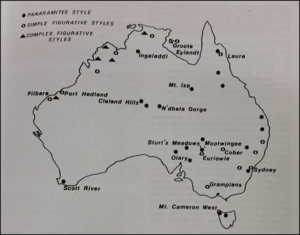Panaramitee Style facts for kids
The Panaramitee Style is a special kind of ancient art found in Australian rock art. It's also called track and circle art. Aboriginal peoples created this art by pecking designs into rock surfaces.
This art style gets its name from the Panaramitee sheep station in the Flinders Ranges of South Australia. This is where these artworks were first officially studied. The art shows many different things. You can see animal tracks, like those of kangaroos, birds, and even humans. It also features designs like circles, spots, crescents, and spirals.
Contents
What is Panaramitee Style Art?
This unique style of petroglyph (rock carving) was first found at several places on the Panaramitee sheep station. You can see these locations on the map in Figure 2.
A person named Herbert Basedow was the first to write about these rock carvings. He looked at many sites in the Panaramitee area. He also suggested that this rock art was very old, possibly from the Pleistocene era, which was a long time ago.
Panaramitee Style rock art is made by hitting a pointed stone (a hammer stone) against the rock surface. This pecks away small pieces of rock to create the design. Sometimes, artists used a large, blunt hammer to make tracks, circles, or cup-shaped marks. This was seen at two sites near the Middle Arm Peninsula in the Northern Territory.
About 60% of this art style shows animal tracks. Circles make up about 20% of the designs. Lines are about 10%, and other interesting motifs like lizards make up the rest.
What Do the Symbols Mean?

In Australian Aboriginal art, circles often represent places where water can be found. Lines that spread out, called radiating lines, can show the path of an ancestral being or important journey.
Many people believe that Panaramitee designs helped travelers. These symbols might have shared important knowledge about the land. They could have shown safe routes or places to find resources like water. The meanings of these symbols could also change over time. Different groups of people might have understood them in different ways.
Where Can You Find This Art?
Besides the Panaramitee sheep station and Middle Arm, Panaramitee Style carvings have been found in many other places across Australia.
For example, you can find them at Wild Dog Creek, inside the Woomera weapons range in South Australia. The Kokatha people carved these long ago. The carvings include kangaroo footprints, human footprints, and symbols for shelters. They tell a lot about the area.
This art style is not just in South Australia. It has been found in central Australia, New South Wales, the Northern Territory (NT), Queensland, and Western Australia. Figure 3 shows a map of Australia with black dots marking where Panaramitee-style sites have been recorded.
Some of these sites include Puritjarra rock shelter, N'Dhala Gorge, Ewaninga, and Ooraminna in central Australia (NT). Other sites are Ingladdi (NT), Early Man cave in Queensland, and possibly Nappapethera Waterhole in southwest Queensland. You can also find them at Sturt's Meadows in New South Wales and Scott River in Western Australia.
There have been some ideas that Panaramitee style art is also in Tasmania. However, many experts think these Tasmanian artworks are much newer, only about 2,000 years old. This would be too recent for the "Classic Panaramitee" style, especially since Tasmania separated from the mainland a very long time ago.
How Old is This Art?
Experts believe the Panaramitee Style is very old. Some studies suggest it could be over 7,000 years old. This is based on dating techniques and studies of the land.
One of the oldest confirmed dates for Panaramitee Style rock art is from Early Man cave. This art is at least 13,000 to 14,000 years old. The art in the Laura region, while similar, has some differences from the "Classic Panaramitee" style. This might mean the style changed as it spread across different areas.
It is important to know that Australian Aboriginal people have continued to create rock art in the Panaramitee Style even today. This shows a long and continuous artistic tradition that has lasted for thousands of years.
See also
 In Spanish: Estilo Panaramitee para niños
In Spanish: Estilo Panaramitee para niños




